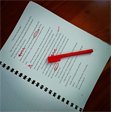 I’ll be honest. I am not a massive fan of editing. I put a lot of thought and effort into first drafts and in many ways, I edit as I go. But as I mentioned in my last post on editing, even the most amazing first draft is going to need revising. And so I doggedly persist. If you want to make the work better, there’s really no choice.
I’ll be honest. I am not a massive fan of editing. I put a lot of thought and effort into first drafts and in many ways, I edit as I go. But as I mentioned in my last post on editing, even the most amazing first draft is going to need revising. And so I doggedly persist. If you want to make the work better, there’s really no choice.
If you google the words ‘editing’ – you’ll probably find a whole bunch of definitions for different types of editing. There’s copy editing, structural editing, line editing, proof-reading etc.
These definitions might be useful in publishing houses where they employ specific editors for specific types of editing. But when you’re revising your own work, they don’t mean a lot – YOU are the copy editor, structural editor, proof reader, line editor etc.
What I’m saying is – editing your own work is different to editing someone else’s. In my experience, when you’re self-editing, it’s more useful to look at the process in terms of the subjective and the objective elements of the work. Or, in even more simple terms, the big picture versus the little picture.
I find it very difficult to be subjective about big picture matters – is a character likeable? Is this an interesting story? Will it seem credible to the readers? This is where an independent reader is helpful, and I’ll be writing more about this in a few weeks when I send off my manuscript for an assessment.
However, the little picture also matters. A story is told word by word. This is how the reader experiences it, and so the individual words need to be the best they can be.
So, before the assessment stage, I am going through the MS with a fine tooth comb and trying to improve the writing, word by word, line by line. What I’m finding is that the corrections generally fall into a few basic categories, which might also help your writing.
To me, they are easy fixes because they are essentially objective errors of the manuscript.
1) Getting rid of ‘weasel words’.
When I finished my manuscript, I did a ‘control F’ search for the number of times I used the word ‘just’. Let’s just say the result was astonishing. ‘Just’ is a ‘weasel’ word – one that adds little to the writing, and tends to diminish from its power. We all have weasel words. Getting rid of them is easy when you identify what they are.
2) Getting rid of the ‘LY’ words
I cringed the other day in my daughter’s Year 1 class as they were encourage to use ‘LY’ words (or adverbs) in their writing – sadly, happily, carefully, quietly. Hey, look, for 6 year olds, adverbs are an easy way to inject expressiveness into the writing. But they have little place in adult writing. Be sparing. Especially when writing dialogue.
3) Under-use and Over-use of punctuation
I am a big fan of the comma. When I’m writing, I mentally read the words aloud in my head and tend to insert a comma for every breath pause. While the concept of reading out loud is good – comma overload is not. Excessive punctuation is distracting, and minimal punctuation can lead to confusion. The balance needs to be right. Only use punctuation where necessary, not for effect.
4) Getting rid of the ‘he saids’, ‘she saids’
I’ve noticed there are some writers who never use dialogue attribution at all and instead rely on the action of the scene and the distinctiveness of the voice to let the reader know who is talking. Generally, this results in the most natural sound dialogue. Of course, it is not always possible to eliminate all of the ‘he saids’ and ‘she saids’ but it’s interesting how much better the dialogue sounds when you keep it to a minimum.
5) Fixing plot and character inconsistencies
In the first draft of manuscript, one of the main characters started with blue eyes, and ended up with green. Another mistake I made was to say that character was 20 weeks pregnant, when that simply didn’t fit within the time frame of the story. What I’m saying is – keep track of the detail. Keep lists of significant character traits so that they’re consistent through out the book. Make a time-line of events to ensure they occur in a credible and consistent time frame.
